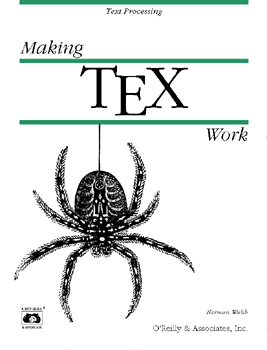
Garden Spider
The animal featured on the cover of Making TeX Work is the European garden spider.Garden spiders are orb weavers, known for their intricate orb-shaped webs. Web building is a complex process: support lines are constructed first; then the radial lines; and finally the spiraling strands are spun from the center outward. Without training from adults, even the tiniest just-hatched spiderlings are able to spin silk and weave webs. Another orb weaver, nephila, builds an extremely thick and strong web, up to eight feet in diameter. People in Southeast Asia have found an interesting use for this spider's web -- they bend a pliable stick into a loop and pass it through the large web, resulting in a surprisingly strong and effective fishing net!
Spiders produce silk from glands called spinnerets. Orb weavers can have three or four pairs of these glands, each producing different textures of silk: non-stick silk for the radial web lines, and sticky silk for the spiraling strands. Some spiders even produce an ultraviolet silk to attract insects. Spider silk, a super protein that hardens as it is stretched from the spinnerets, may look delicate but it is unbelievably tough. The relative tension necessary to break it is far greater than for steel.
When finished with the construction of its web, the garden spider will often go to the center, hang upside down, and wait for a flying or jumping insect to become ensnared. Having poor eyesight, orb weavers rely on a highly-developed sense of touch. When an insect becomes caught in the web and struggles, the spider is alerted by the vibrations. It rushes out to secure its prey, usually wrapping it in silk. A poison is injected into the victim, paralyzing it and converting the contents of its body to liquid. The spider returns later to insert its tube-like fangs and suck up its meal.
The garden spider's profound sense of touch has another purpose: it provides male spiders with a channel to communicate with females. Before climbing onto the female's web, the male taps out a special message. Then he cautiously crawls toward his mate -- a perilous task, for he is always in danger of being mistaken for prey. It is commonly thought that the female spider kills and eats the male after mating, but this is an exaggeration. The male, who stops eating during his mate-hunting ordeal, generally dies of malnourishment and exhaustion.
Spiders are similar to, but not the same as insects. They belong to the class Arachnida, named after Arachne, a maiden in Greek mythology. She defeated the goddess Athena in a weaving contest. In a fury of anger, Athena destroyed Arachne's weaving and beat the girl about the head. In utter disgrace, Arachne hanged herself. A regretful Athena changed Arachne into a spider so that she could weave forever.
While they are certainly not going to win any popularity contests, spiders' insect-eating habits are extremely helpful to humans. Every year, billions of spiders do away with a large number of disease-carrying and crop-destroying insects. If every spider ate just one a day for a year, those insects, piled in one spot, would weigh as much as 50 million people. Spiders are, by far, the most important predator of insects in our world.
researched and written by Elaine Kalantarian
(with help from Michael Kalantarian)
A nice note...
From: James S. Campbell <103127.1000@compuserve.com> Subject: Thanks for Garden Spider Site Just a note to say thanks for a little help with my 9 year old. Hannah needed to write a report about a spider. I suggested writing about a type that had a little more info on the web. But nothing else but a garden spider would do. Rest assured, I instructed her to give credit to you and your site in her 4th grade report.